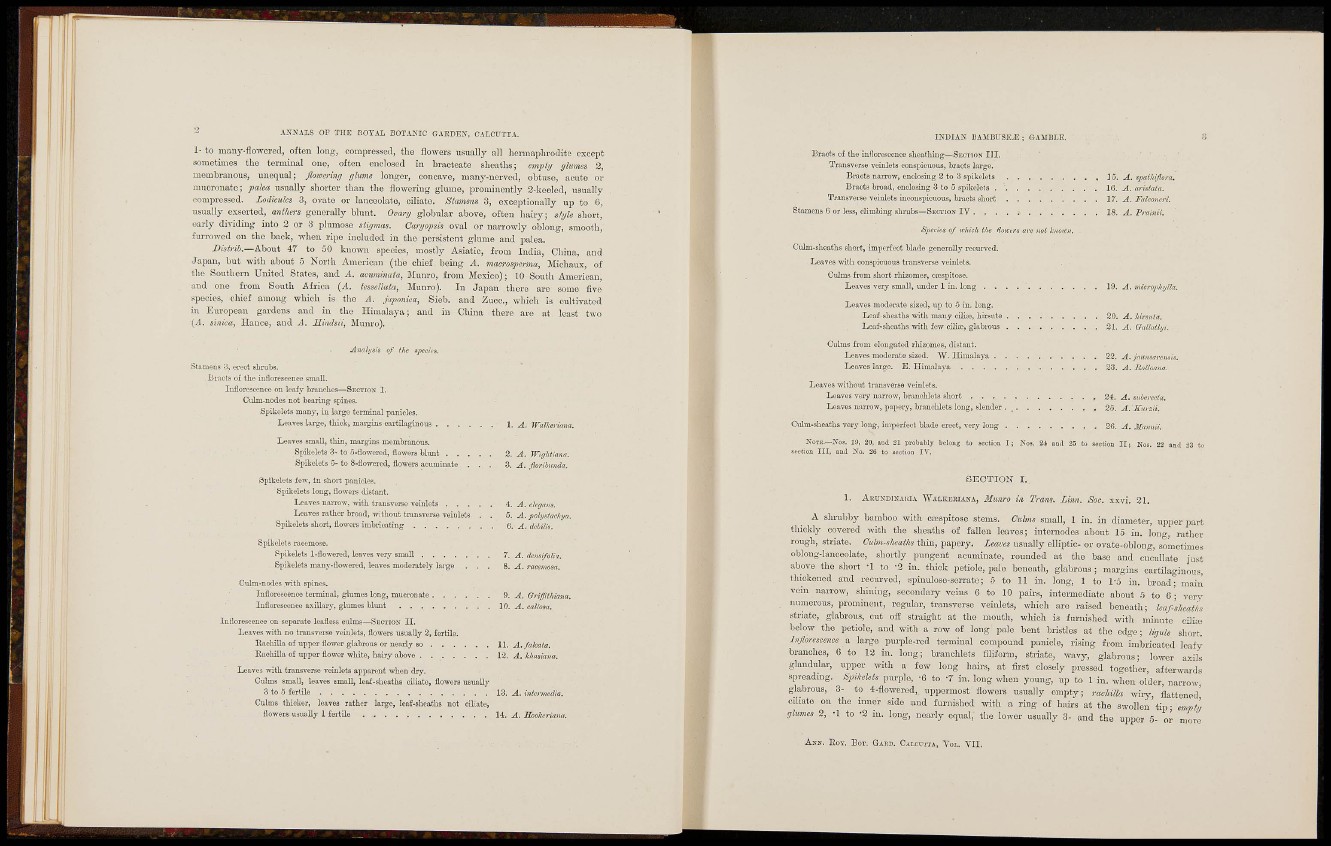
ANNALS OF THE ROYAL BOTAKIC GAEDEN, CALCUTTA.
1- to luany-flo-werecl, often long, compressed, the flowers usually all liennaplirodite except
sometimes tho terminal one, often enclosed iu braoteate sheaths; cm-piij glumes 2,
membranous, unequal; jlotm-ing gluvie longer, concave, many-norvcd, obtuse, acato or
imicronate; palea usually shorter than the flowering glume, prominently 2-kceled, usually
compressed. Lodicules 3, ovate or lanceolate, eiliate. Stamens 3, exceptionally up to 6,
usually exsorted, anthers generally blunt. Ovary globular above, often hairy; sbjle short,
early dividing into 2 or 3 plumose stigmas. Caryopsis oval or narrowly oblong, smooth,
furro^-ed on the back, when ripe included in tho persistent glume and palea.
Disíni.—About 47 to 50 known species, mostly Asiatic, from India, China, and
Japan, but with about 5 North American (the chief being A. macrosperma, Michaux, of
the Southern United States, and A. acuminata, Munro, from México); 10 South American,
and one from South Africa (.4. tesseUata, Manro). In Japan there are some five
species, chief among which is the Japónica, Sieb. and Zucc., which is cultivated
in European gardens and iu the Himalaya; and in China there aro at least two
(/I. sinica, Ha nee, and A. Hinthii, Munro).
Amlym of fhe »pecm.
Stamens -3, erect shruljs.
iiracts 01 the iafloi-escence small.
lofloi-Gscence on leafy bmnclios—8eci'iox I.
Cuka-nodes not tearing spines.
Spikelets many, in large terminal panicles.
Leaves large, thick, margins cartilaginous I. A. Walkeriuna.
Leaves small, thin, margins mombranous.
Spikoleta 3- to 5-flowered, fiowers blunt 2. A. Wirjhtiana.
Spikelets 5- to 8-flowered, flowers aeiimiuate . . . 3. .4. fiorihimda.
Spikelets few, in short panicles.
Spikelets long, flowei-s distant.
Leaves naiTow, with transverse veinlets 4. ehgom.
Leaves rather broad, -without transverse veiolets . . 5. A. polysiaclnja.
Spikelets short, flowers imbricating 6. A. dehilis.
Spikelets racemose.
Spikelets l-llowered, leaves very small 7. A. demifolia.
Spikelets many-flowered, leaves moderately large . . . 8. .<4. racemosa.
Culm-nodes ^ith spines.
Inflorescence tonninal, glumes long, mucronate 9. A. Gnffiiliiana.
Liflorescence axOlary, glumes blimt 10. .<4. calloia.
Inflorescence on separate leafless culms—SECTION II,
Leaves with no transverse veinlets, flowers usually 2, fertUe.
Eachilla of upper flower glabrous or nearly so 11. A.fnkafa.
Eachilla of upper flower white, hairy above 12. ¿1. kimiana.
Leaves with transveree veinlets apparent when dry.
Ciilms small, leaves Email, leaf-sheaths ciliato, flowers usually
3 to 5 ferlile 13. intermedia.
Culms thicker, leaves rather lai^e, leaf-sheaths not eiliate,
flowers usually 1 fertile 14^. A. Eookcriam.
IKDIAN BAMBUSEiE; GAMBLE.
Bracts of the inflorescence sheathing—SECTION I I I.
Transverse veinlets conspicuous, bracts large.
Bracts narrow, enclosing 2 to 3 spikelets 15. A. spathiflora.
Bracts broad, enclosing 3 to 5 spikelets . ' IG. A. aristata.
Transverse veinlets mcouspiouous, bracts short 17.-4. Fideoncri.
Stamens 6 or less, climbing shi-ubs—SECTIOS IV 18. A. Prainii.
Species of which the Howtrs a
Culm-sheaths short, imperfect blade generally recurved.
Leaves with conspicuous transverse veinlets.
Culms from short rhizomes, cfespitose.
Leaves very small, \mdcr 1 iu. long . . . .
? not inotcn.
Leaves moderate sized, up to 5 in. long.
Leaf-sheaths with many ciliio, hirsute .
Leaf-sheaths with few cilice, glabi-ous .
Cuhns ñ-om elongated rliizomes, distant.
Leaves moderate siaed. W. Uimalaya .
Leaves largo. E. Himalaya . . . .
Leaves without ti'ansverse veinlets.
Leaves very narrow, branchlets short
Leaves uarww, papery, branchlets long, slender . _. .
Culm-sheaths very long, imperfect blade erect, very long . . .
KOTE.—JS'os. 10, 20, and 21 probably belong to section I; Nos, 24 and
sc-etioa III, and No. 26 to section IV.
nicrophyUa.
20. A. hirsuta.
2L A. Gallatlyi.
22. A. jaunm-enm,
23. A. liollocma.
24. A. siibcrceia.
25. A. Kurzii.
26. A. Mamii.
to section I I ; Nos. 22 and 23 to
SECTION I.
1. Auundinauia Walkekiana, Munro in Trans. Linn. Soe. sxvi. 21.
A shnibby bamboo with cfespitose stems. Culms small, 1 in. in diameter, upper part
thickly covered with the sheaths of fallen leaves; internodes about 15 in. long, rather
roug-h, striate. Culm-sheaths thin, papery. Leaves usually elliptic- or ovate-oblong, sometimes
oblong-lanceolate, shortly pungent acuminate, rounded at the base and cucullate just
above the short 'I to -3 in. thick petiole, palo beneath, glabrous; margins cartilaginous,
thickened and recurved, spinulose-serrato; 5 to 11 in. long, 1 to l-o in. broad- main
vein narrow, shining, secondary veins 6 to 10 pairs, intermediate about 5 to 6; very
numeroxis, prominent, regular, transverse veinlets, which are raised beneath; leaf-shaatL
striate, glabrous, cut off straight at the mouth, which is furnished with minute ciliiti
below the petiole, and with a row of long pale bent bristles at the edge; Ugule short.
Inflorescence a largo purple-red terminal compound panicle, rising from imbricated leafy
branches, G to 12 in. long; branchlets filiform, striate, wavy, glabrous; lower aziis
glandular, upper with a few long haii-s, at first closely pressed together, afterwai-ds
spreading. Spikelets pm-ple, "G to T in. long when young, up to 1 in. when older, narrow
glabrous, 3- to 4-flowered, uppermost flowers usually empty; rachilla wiiy, flattened
ciliate on the inner side and furnished with a ring of haii-s at the swollen tip- en.phr
flumes 2, -1 to '2 in. long, nearly equal, the lower usually 3- and the upper 5- oi more
PN. Hot, Bot. Gard. Calcutia, Yol, VIL